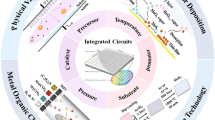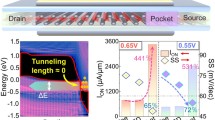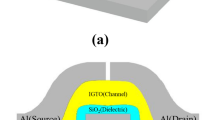Abstract
Monolayer molybdenum disulfide (MoS2) is considered an alternative two-dimensional material for high performance ultra-thin field-effect transistors. MoS2 is a triple atomic layer with a direct 1.8 eV bandgap. Bulk MoS2 has an additional indirect bandgap of 1.2 eV, which leads to high current on/off ratio around 108. Flakes of MoS2 can be obtained by mechanical exfoliation or grown by chemical vapor deposition. Intrinsic cut-off frequency of multilayer MoS2 transistor has reached 42 GHz. Chemical doping of MoS2 is challenging and results in reduction of contact resistance. This paper focuses on modeling of dual-gated monolayer MoS2 transistors with effective mobility of carriers varying from 0.6 cm2/V s to 750 cm2/V s. In agreement with experimental data, the model demonstrates that in back-gate bias devices, the contact resistance decreases almost exponentially with increasing gate bias, whereas in top-gate bias devices, the contact resistance stays invariant when varying gate bias.
Similar content being viewed by others
References
K.S. Novoselov, A.K. Geim, S.V. Morozov, D. Jiang, Y. Zhang, S.V. Dubonos, I.V. Grigovieva, and A.A. Firsov, Science 306, 666 (2004).
K.F. Mak, C. Lee, J. Hone, J. Shan, and T.F. Heinz, Phys. Rev. Lett. 105, 136805 (2010).
E. Cheng, S. Jiang, Y. Chen, Y. Li, N. Weiss, H. Cheng, H. Wu, Y. Huang, and X. Duan, Nat. Commun. 5, 5143 (2014).
B. Radisavljevic, A. Radenovic, J. Brivio, V. Giacometti, and A. Kis, Nat. Nano 6, 147 (2011).
X. Li, X. Wang, L. Zhang, S. Lee, and H. Dai, Science 319, 1229 (2008).
C. Jiang, S.L. Rumyantsev, R. Samnakay, M.S. Shur, and A.A. Balandin, J. Appl. Phys. 117, 064301 (2015).
S. Bertolazzi, J. Brivio, and A. Kis, ACS Nano 5, 9703 (2011).
F.K. Perkins, A.L. Friedman, E. Cobas, P.M. Campbell, G.G. Jernigan, and B.T. Jonker, Nano Lett. 13, 668 (2013).
S. Butun, S. Tongay, and K. Aydin, Nano Lett. 15, 2700 (2015).
H. Wang, L. Yu, Y.-H. Lee, Y. Shi, A. Hsu, M.L. Chin, L.-J. Li, M. Dubey, J. Kong, and T. Palacios, Nano Lett. 12, 4674 (2012).
N. Pour, Y. Anugrah, S. Wu, X. Xu, and S.J. Koester, Conference Digest, IEEE 71st Device Research Conference (2013).
S.-J. Han, D. Reddy, G.D. Carpenter, A.D. Franklin, and K.A. Jenkins, ACS Nano 6, 5220 (2012).
R.S. Muller and T.I. Kamins, Chapters 8–9, Device electronics for integrated circuits, 3rd ed. (New York: Wiley, 2003).
M. Cheli, P. Michetti, and G. Iannaccone, IEEE Trans. Electron Dev. 57, 1936 (2010).
T.-Y. Kim, M. Amani, G.H. Ahn, Y. Song, A. Javey, S. Chung, and T. Lee, ACS Nano 10, 2819 (2016).
S. Fregonese, M. Magallo, C. Maneux, H. Happy, and T. Zimmer, IEEE Trans. Nanotech. 12, 539 (2013).
L. Liao, J. Bai, Y. Qu, Y.-C. Lin, Y. Li, Y. Huang, and X. Duan, Proc. Nat. Acad. Sci. 107, 6711 (2010).
D. Lembke and A. Kis, ACS Nano 6, 10070 (2012).
H. Liu, M. Si, S. Najmaei, A. Neal, Y. Du, P. Ajayan, J. Lou, and P. Ye, Nano Lett. 13, 2640 (2013).
I. Popov, G. Seifert, and D. Tománek, Phys. Rev. Lett. 108, 156802 (2012).
Author information
Authors and Affiliations
Corresponding author
Rights and permissions
About this article
Cite this article
Tran, P.X. Variations of Contact Resistance in Dual-Gated Monolayer Molybdenum Disulfide Transistors Depending on Gate Bias Selection. J. Electron. Mater. 46, 3390–3395 (2017). https://doi.org/10.1007/s11664-016-5276-9
Received:
Accepted:
Published:
Issue Date:
DOI: https://doi.org/10.1007/s11664-016-5276-9




